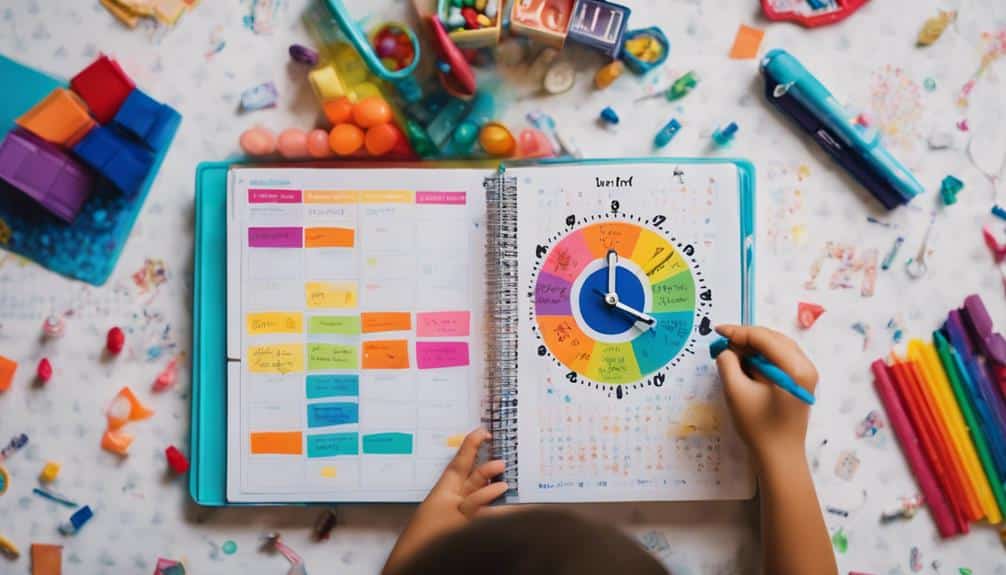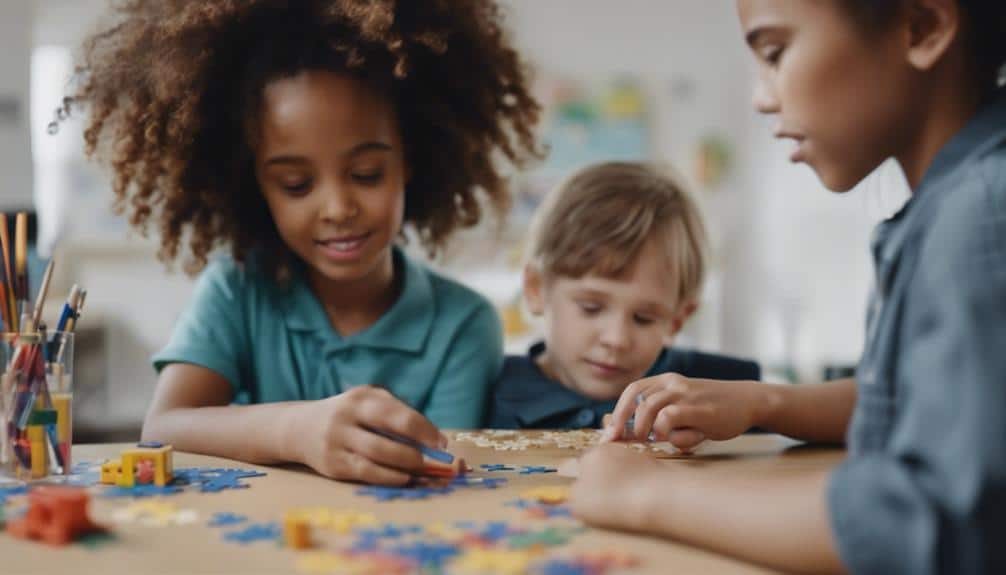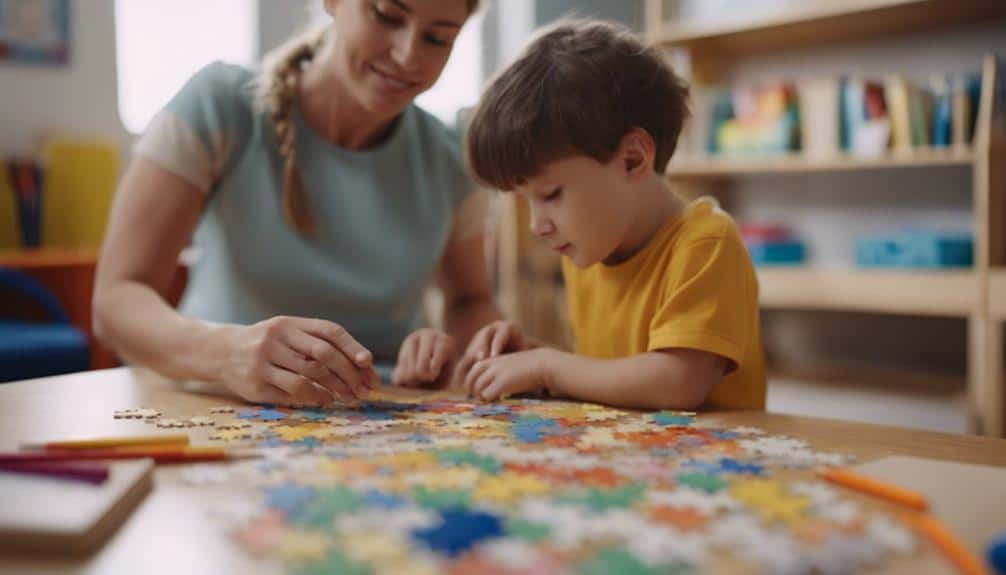Parents and teachers, when dealing with a struggling student, it’s crucial to recognize the significant impact of pediatric occupational therapy (OT) on boosting academic success. Occupational therapists systematically address fine motor skills, sensory processing, and cognitive functions, providing essential support to enrich a child’s learning environment. This multidimensional approach is crucial in boosting academic success by enhancing handwriting and organizational skills while fostering an inclusive emotional and social development atmosphere.
As we explore this critical juncture, it becomes evident that tailored OT interventions can profoundly transform the academic landscape for students. Let’s closely examine evidence-based strategies and their practical implementation in educational settings to ensure we genuinely boost academic success.
Key Takeaways
- Pediatric OTs are crucial in the early detection and intervention of learning challenges.
- Fine motor skills development is critical to academic tasks, including writing.
- Sensory integration techniques by OTs significantly boost writing proficiency and overall academic success.
- Tailored support from OTs promotes holistic development, enhancing academic progress and emotional well-being.
Identifying Learning Challenges
Understanding and identifying learning challenges in children is a critical step toward ensuring their successful academic journey and overall well-being. These challenges, often subtle yet impactful, can manifest in various forms, including difficulties with attention, organization, memory, or sensory processing. Such impediments hinder academic progress and affect social interactions and participation in school activities, making early detection and intervention paramount.
Pediatric occupational therapists play a pivotal role in this early identification process, employing comprehensive assessments to pinpoint the specific areas where a child may struggle. Common signs indicating learning challenges include difficulties with reading, writing, math, following instructions, or maintaining focus in the classroom environment. Recognizing these signs early can lead to timely and targeted interventions.
Empowering parents, educators, and caregivers with the knowledge to spot these challenges is essential. Through informed, empathetic, and practical approaches, pediatric occupational therapy offers strategies and supports to enhance a child’s capacity to learn and engage significantly. By addressing learning challenges head-on, we lay a strong foundation for a child’s academic progress and general well-being, underscoring the invaluable role of pediatric occupational therapy in fostering academic success.
Enhancing Fine Motor Skills
Enhancing fine motor skills through pediatric occupational therapy is a critical step toward fostering academic achievement and daily independence in children. Therapists provide the tools necessary for tasks ranging from handwriting to self-care activities by focusing on building hand strength and improving writing grip. These targeted interventions support children in their educational pursuits and empower them with confidence in their abilities to navigate everyday challenges.
Building Hand Strength
Focusing on building hand strength in children, pediatric occupational therapy employs targeted activities to significantly improve fine motor skills necessary for academic achievements and daily functions. Through an empathetic and practical approach, therapists engage children in exercises that serve immediate needs and prepare them for future challenges.
- Fine Motor Enhancement: Activities like squeezing playdough or tweezers refine agility and coordination, which are crucial for tasks requiring fine motor skills.
- Handwriting Legibility: Hand strength is vital for improving pencil grasp, directly influencing a child’s handwriting quality and speed.
- Pencil Grasp Proficiency: Targeted exercises promote effective grasp patterns, enhancing control and endurance for writing and other academic tasks without improving writing grip.
This holistic approach ensures children gain the hand strength needed to succeed academically and in daily life.
Improving Writing Grip
Building upon the foundation of hand strength, the next crucial step in pediatric occupational therapy involves refining children’s writing grip to improve their handwriting legibility and speed further. Children can enhance their hand strength by engaging in specific fine motor activities, such as manipulating small tools or squeezing playdough, essential for developing a functional pencil grasp. The research underscores the significance of a mature pencil grasp, highlighting its positive correlation with writing fluency and accuracy.
Pediatric occupational therapists employ specialized tools and techniques to overcome grip strength and coordination challenges, ensuring every child can achieve a comfortable and efficient pencil grip. Addressing these issues alleviates discomfort and fatigue during writing tasks and paves the way for academic success by fostering confidence and independence in written expression.
Developing Writing Abilities

Building on the foundation of enhancing fine motor skills and developing writing abilities in children requires a multifaceted approach. Implementing sensory integration techniques, alongside targeted occupational therapy interventions, can address the complex needs of children struggling with writing tasks. This holistic strategy supports improving hand strength and coordination and ensures sensory processing challenges are met with effective, personalized solutions.
Enhancing Fine Motor Skills
How can occupational therapy effectively enhance fine motor skills essential for developing proficient writing abilities in children? Occupational therapy targets refining fine motor skills, which are foundational for handwriting proficiency and, by extension, academic performance. Interventions focus on:
- Strengthening Hand and Finger Muscles: Enhancing hand strength and coordination directly influences a child’s ability to control writing instruments, improving legibility and speed.
- Improving Precision in Finger Movements: Precision is crucial for tasks like writing, where the ability to form letters neatly depends on finely controlling finger movements.
- Increasing Wrist Stability: A stable wrist supports the hand, enabling more controlled writing movements and improving handwriting proficiency.
These targeted strategies ensure occupational therapy is pivotal in advancing a child’s writing abilities and fostering academic success.
Implementing Sensory Integration Techniques
Sensory integration techniques employed in pediatric occupational therapy enhance children’s writing abilities by addressing underlying sensory processing challenges. These methods improve a child’s ability to effectively process and respond to sensory information, which is critical for successful writing tasks. Pediatric OTs aim to foster writing readiness Through tactile stimulation, proprioceptive input, and vestibular activities.
Such sensory strategies are vital in improving handwriting legibility, speed, and overall proficiency. Furthermore, sensory integration techniques are crucial in promoting sensory-motor development, leading to better fine motor control and precision for writing tasks. Focusing on sensory processing and visual-motor integration offers a comprehensive approach to developing writing abilities in children.
Promoting Sensory Integration
Enhancing the brain’s ability to process and respond to sensory information effectively is a cornerstone of pediatric occupational therapy that promotes sensory integration. This specialized approach is instrumental in helping children navigate their sensory world, thereby supporting their academic progress and overall development. In pediatric OT, sensory integration is more than just a method; it’s a pathway to unlocking a child’s potential in educational settings and daily life.
- Targeted Intervention: Sensory integration in pediatric OT employs tailored activities to help children better regulate their responses to sensory input. This is crucial for children with sensory processing challenges, autism spectrum disorders, ADHD, and other developmental conditions.
- Enhanced Learning Outcomes: By improving sensory processing capabilities, pediatric OT supports heightened attention and behavior, foundational to successful learning and academic achievement.
- Optimized School Participation: Addressing sensory integration issues enables children to engage more fully in academic tasks and social interactions, laying the groundwork for a more inclusive and accessible learning environment.
Pediatric OT champions the cause of sensory integration to foster an educational journey that is both enriching and accommodating, ensuring that every child has the opportunity to thrive academically.
Improving Hand-Eye Coordination

Hand-eye coordination is pivotal in a child’s ability to master everyday academic and recreational activities, from writing to sports. This intricate skill, often called visual motor integration, is foundational for successfully executing tasks that demand precision and accuracy. Pediatric occupational therapy offers a pathway to enhance this essential skill through targeted activities and exercises.
Interventions tailored by occupational therapists are grounded in research and practice to elevate a child’s hand-eye coordination. This, in turn, can significantly impact their academic performance and participation. Activities such as puzzles, which require fitting pieces together, building blocks that demand stacking in precise patterns, and ball games that necessitate accurate catching and throwing, are instrumental in developing these skills. Each activity is designed to engage and challenge the child, improving their ability to perform tasks that require visual motor integration, like handwriting, drawing, scissors, and threading beads.
The benefits of improved hand-eye coordination extend beyond the classroom, influencing children’s confidence and ability to engage in sports and other recreational activities. Through occupational therapy, children have the skills necessary for academic success and a fulfilling educational experience.
Fostering Social Skills
While improving hand-eye coordination lays a foundation for academic success, fostering social skills is equally critical in ensuring children can navigate the complexities of interpersonal relationships effectively. Pediatric occupational therapists play a pivotal role in this area, employing various strategies to enhance children’s social-emotional development, cognitive skills, and organizational abilities in social contexts.
- Structured Activities for Skill Building: Through activities like turn-taking, sharing, and effective communication, therapists create a supportive environment that encourages children to engage with peers. This hands-on approach facilitates social interaction and promotes the development of empathy and conflict-resolution skills, which are crucial for social integration in school and community settings.
- Utilization of Social Stories and Role-Playing: These methods help children understand social cues and develop appropriate responses. By simulating real-life scenarios, children learn to navigate social situations, enhancing their cognitive skills related to social interaction.
- Evidence-Based Interventions for Targeted Support: Therapists use proven strategies to address specific social deficits, thereby supporting children in overcoming challenges and participating more fully in social engagements. This tailored approach ensures that each child receives the support they need to develop robust social skills.
In fostering social skills, pediatric occupational therapy contributes significantly to a child’s holistic development, preparing them for a future of meaningful interpersonal relationships and academic success.
Strengthening Organizational Techniques

Pediatric occupational therapists employ various strategies to assist children in developing organizational techniques crucial for improving time management skills and academic productivity. By introducing tools such as visual schedules, checklists, color-coding systems, and electronic reminders, OTs enable young learners to structure their day-to-day activities better.
These organizational techniques not only help in prioritizing tasks but also play a significant role in reducing procrastination, thereby facilitating smoother task completion.
The research underscores the importance of organizational skills for academic success, revealing that more organized students tend to achieve higher levels of academic performance while experiencing less stress. Occupational therapy interventions are tailored to equip children facing organizational challenges to break tasks into manageable parts, set realistic goals, and adhere to structured routines. This comprehensive approach ensures that students not only keep up with their academic responsibilities but also gain a sense of accomplishment and confidence in their ability to manage their work effectively.
Supporting Emotional Regulation
Supporting emotional regulation in pediatric occupational therapy encompasses a multifaceted approach aimed at enhancing a child’s ability to navigate academic and social challenges with resilience. By identifying emotional triggers, therapists equip children with personalized strategies, such as calming techniques and sensory interventions, fostering a stable foundation for emotional well-being. Expressive communication further empowers children, enabling them to articulate their feelings and needs effectively, promoting a conducive learning environment and positive peer interactions.
Identifying Emotional Triggers
Identifying emotional triggers, a critical component of supporting emotional regulation involves understanding the specific situations, people, or events that can provoke intense emotional responses in children. Pediatric occupational therapists (OTs) play an essential role in this process, guiding children to recognize and manage these triggers effectively. This understanding is foundational to fostering better focus, self-control, and well-being in academic settings.
- Recognize Specific Situations: Identify the contexts in which emotional triggers are likely to occur.
- Understand Individual Responses: Acknowledge how different children may respond uniquely to similar triggers.
- Implement Support Strategies: Utilize coping skills, self-awareness exercises, and relaxation techniques to aid emotional regulation.
Through these steps, pediatric OTs can significantly contribute to a child’s academic progress by managing emotional triggers constructively.
Techniques for Calming
To effectively enhance emotional regulation among children, pediatric occupational therapists employ various calming techniques, ranging from deep breathing exercises to sensory tools. These methods are pivotal in reducing anxiety, promoting relaxation, and helping children stay focused. Sensory strategies, including weighted blankets or fidget tools, play a crucial role in assisting children to manage their emotions. Creating a calming sensory corner in educational settings also offers a dedicated safe space for self-regulation and de-escalation.
This approach is complemented by visual supports like calm-down cards or emotion charts, which aid children in identifying and navigating their feelings more effectively, fostering a nurturing environment conducive to learning and emotional growth.
Encouraging Expressive Communication
Pediatric occupational therapists implement strategies that facilitate emotional regulation and significantly enhance children’s ability to express themselves clearly and confidently. These strategies include employing sensory tools and visual supports tailored to each child’s unique needs and fostering an environment where emotional regulation and expressive communication are closely interlinked. By focusing on these aspects, occupational therapists play a crucial role in supporting children’s academic progress and social interactions.
- Sensory Tools: Utilizing weighted blankets or fidget toys to help children manage sensory overload and focus on expressing their feelings.
- Visual Supports: Implementing emotion charts and visual schedules to aid children in understanding and communicating their emotions more effectively.
- Tailored Techniques: Incorporating personalized strategies like deep breathing exercises and social stories to enhance emotional regulation and expressive communication skills.
Encouraging Independent Living Skills
Fostering independent living skills in children, occupational therapists employ strategies to teach essential self-care tasks, promoting a significant leap toward autonomy in daily activities. By addressing key areas such as dressing, feeding, and grooming, occupational therapists lay the groundwork for children, especially those with physical or cognitive challenges, to lead more independent lives. Doing so contributes to the children’s academic progress and enhances their overall quality of life.
Employing techniques such as task analysis, occupational therapists break down complex activities into manageable steps for children to understand and master. The use of adaptive equipment further supports this learning process, enabling children to perform tasks more efficiently and independently. Moreover, a focus on developing executive functioning skills is pivotal. By enhancing planning, organization, and time management abilities, occupational therapists ensure that children are better equipped to manage their daily routines and responsibilities.
Through these interventions, pediatric occupational therapy plays a crucial role in empowering children to navigate the challenges of daily life with confidence. This holistic approach supports academic progress and fosters a sense of independence, self-esteem, and a positive outlook toward future endeavors.
Tailoring Individual Education Plans

Building upon the foundation of enhancing independent living skills and tailoring Individual Education Plans (IEPs) emerges as a critical step in supporting students’ unique academic and developmental journeys. Pediatric occupational therapists (OTs) are instrumental in crafting IEPs that address the specific needs of each student, ensuring a path toward academic success and personal growth. By working collaboratively with educators and parents, OTs ensure that these plans are personalized but also practical and achievable.
- Individualized Attention: IEPs are designed to cater to the unique needs of each student, ensuring that academic, developmental, and functional goals are met. This individualized approach fosters a supportive learning environment where students can thrive.
- Collaborative Design: The involvement of occupational therapists, educators, and parents in the IEP process ensures that every plan is aligned with the student’s personal and academic goals. This collaboration is critical to creating a holistic and effective support system.
- Ongoing Evaluation: Regular review and adjustment of IEPs by pediatric OTs are essential to track progress and adapt strategies as needed. This dynamic approach allows for continuous support and optimal academic enhancement.
Frequently Asked Questions
How Do Occupational Therapists Improve a Student’s Occupational Performance in Education?
Occupational therapists enhance students’ educational performance by developing fine motor skills, improving visual-motor integration, offering sensory processing strategies, teaching organizational skills, and bolstering cognitive functions, facilitating a more effective and efficient learning experience.
Why Is Pediatric OT Important?
Pediatric occupational therapy is a miraculous key to unlocking children’s potential and transforming struggles into strengths. It holistically supports development, ensuring every child can confidently navigate educational landscapes and fostering lasting academic and personal growth.
How does Pediatric Occupational Therapy contribute to boosting academic success for your child?
Parents often seek occupational therapy in schools, hoping it will aid their child in mastering fine motor skills, enhancing focus, improving organizational abilities, and developing self-regulation to navigate academic challenges more effectively and confidently.
What Are the Top 3 Qualities You Think a School OT Needs to Have to Be Successful, and Why?
The top three qualities of a successful school-based OT include excellent communication, strong problem-solving abilities, and empathy. These ensure effective collaboration, tailored interventions, and a supportive, trust-building relationship with students facing academic challenges.
Conclusion
Pediatric occupational therapy is a holistic approach to enhancing children’s academic performance, developmental growth, and overall quality of life. It addresses challenges children face in their daily activities, such as developmental delays, physical disabilities, and sensory processing issues. The therapy focuses on improving cognitive and communication skills, attention span, motor coordination, and social interactions. Occupational therapy practitioners work with children in various settings, including schools and natural environments, to help them participate in academic tasks and everyday activities.
School-based occupational therapy is an evidence-based practice that has proven effective in improving academic achievement and participation levels. Children with disabilities such as Attention Deficit Hyperactivity Disorder (ADHD), Autism Spectrum Disorder (ASD), Developmental Coordination Disorder (DCD), and intellectual disability benefit from occupational therapy intervention approaches. Sensory integration therapy, social skills training, motor skills training, and functional task performance training are some therapeutic practice approaches used in occupational therapy.
Occupational therapy practitioners also provide additional training to parents and school teachers to help them support children with challenges in motor skills, literacy participation, and academic participation. The therapy aims to help children achieve age-appropriate tasks and participate in daily life, improving their emotional well-being and overall experience. The British Journal of Occupational Therapy, American Journal of Occupational Therapy, Occupational Therapy International, and Occupational Therapy Journal have published research papers supporting the effectiveness of occupational therapy practitioners’ interventions.
In conclusion, occupational therapy is an insightful approach to help children with disabilities overcome challenges in their daily tasks and improve their academic performance, social skills, and overall participation level. The therapy’s focus on natural and educational environments and its evidence-based practice make it an effective intervention for children facing a wide range of physical and mental health issues.


Recent Comments